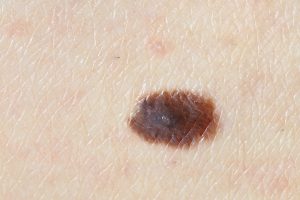
No one wants to find a spot on the comes up on their skin and wonder, “Could it be… skin cancer?” Nor do they want to hear from their doctor, “you have skin cancer.”
But what if something pops up and it doesn’t look just right? Here are some quick tips to help you know if a spot could be suspicious for skin cancer. Just remember your ABCs… that is ABCDE! The ABCDE rule was developed to help people determine if a mole, freckle, or spot is normal or if it needs to be checked out by a Dermatologist.
- Asymmetry: Is your mole or freckle asymmetrical? If one side of the spot, mole, or freckle appears to be a mirror image of the other side, then it is most likely normal.
- Border: Is the border of your spot uneven? Does it contain edges that seem to be blurred or ragged?
- Color: Does your mole or freckle have different colors? Melanoma can sometimes be disguised in a common mole or freckle, but it will appear as a different color.
- Diameter: Is the diameter larger than a pencil eraser? Anything larger than ¼” needs to be evaluated.
- Evolving: Has your mole or spot changed over time? Spots, moles, or freckles that seem to change any (following the ABCD’s above) need to be evaluated by a Dermatologist.
If you answered “yes” to any of the questions above, then you should schedule an appointment with a Dermatologist to have the spot examined.
The ABCDE rule will work for checking any spot – not just a freckle or a mole. More common skin cancers such as basal and squamous cell skin cancer will appear as red patches on your skin, but you will notice they will also follow the ABCDE rule. Oftentimes, they will appear as a red, scaly or dry patch a skin that evolves and does not go away.
If you have any area of concern on your skin, do not hesitate to make an appointment to see your dermatologist.
Disclaimer: This blog provides general information and discussion about medical, cosmetic, mohs, and surgical dermatology. The words and other content provided in this blog, and in any linked materials, are not intended and should not be construed as medical advice. If the reader or any other person has a medical concern, he or she should consult with an appropriately-licensed dermatologist or other health care worker.
